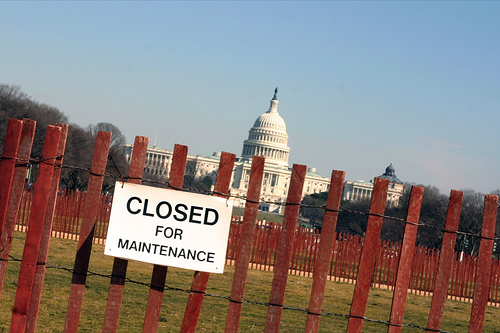(Possible) Results of a Government Shutdown
 As Americans watch their lawmakers bicker and pontificate on how to fix the budget, we thought it would be helpful to gather some of the possible services that would slow or stall if the government shuts down. Of course, ‘shutdown’ isn’t a wholly accurate term, as many vital government services will continue to function and the United States will not become an anarchy overnight. As the final and frantic negotiations take place on the Hill, government offices are quietly prepping for the shutdown that would start after midnight this Friday. We will not know the specifics for this shutdown until each agency releases their individual updated plans, which the American Federation of Government Employees union is currently suing OMB to obtain.
As Americans watch their lawmakers bicker and pontificate on how to fix the budget, we thought it would be helpful to gather some of the possible services that would slow or stall if the government shuts down. Of course, ‘shutdown’ isn’t a wholly accurate term, as many vital government services will continue to function and the United States will not become an anarchy overnight. As the final and frantic negotiations take place on the Hill, government offices are quietly prepping for the shutdown that would start after midnight this Friday. We will not know the specifics for this shutdown until each agency releases their individual updated plans, which the American Federation of Government Employees union is currently suing OMB to obtain.
The following examples are based on previous shutdowns and many services are up in the air, as many services can be labeled essential. Note these are examples are for federal services, not local or state government operations – though everyone will be hurting during a shutdown. Essentially, the determination still needs to be made over excepted activities and personnel. It looks like most congressional staff will report for work. Paychecks for salaried government employees will likely be delayed, even for those considered essential, and while the pay is not guaranteed, budgets passed following a shutdown traditionally provided backpay, though questions remain if that will happen now.
Members of the military and senior government officials like the President, members of Congress and presidential appointees will continue to be paid. Essential employees who are asked to ‘volunteer’ their services must fall under three categories (via OPM Furlough 2011 and Committee on House Administration):
- Activities that entail or directly support Members’ performance of their constitutional responsibility
- Activities that entail the safe-guarding of human life
- Activities that entail the protection of property
Here’s a rundown of government services that could remain open or be crippled by congressional inaction. The main sources, if not linked, are the OMB Furlough Memos, which update the OMB Memo on November 17, 1981.
Likely to Remain Open:
- President, members of Congress and senior government officials – with most of their staff
- The military – regardless of stationing location
- Justice system including federal courts (at least for 10 days) and correctional facilities
- Firefighters, police and Federal Bureau of Investigation (FBI)
- Border, coastal protection and surveillance
- Medical care of inpatients and emergency outpatient care
- Medicare and Medicaid – delayed checks possible
- Air traffic control and Transportation Security Administration (TSA)
- Public utilities
- Emergency and disaster assistance
- Personnel involved in the ‘essential elements of the money and banking system’ – (so, still pay your taxes, but the refunds will likely be delayed)
- Personnel involved in the ‘orderly suspension of agency operations’
- Food inspections and pollution monitoring
- Congressional Research Service
- Federal Reserve (does not rely on appropriations)
- US Postal Service (self-funded)
- Government websites (will remain online but non-essential sites will not updated)
Likely to be Slowed or Closed (CRS Report – 2/8/11):
- Processing of benefits for Veterans and Social Security
- New applications for Medicare, Medicaid, Social Security or Veterans benefits
- Closure of national museums and parks (estimated loss of 9 million visitors during the last shutdown)
- Smithsonian Institution and National Zoo (thankfully animal manure management has improved)
- White House will be ‘significantly lower staffing levels‘
- Patent and Visa processing (Last time 20,000-30,000 applications by foreigners per day and 200,000 U.S. applications for passports were not processed)
- Two-thirds of the State department would be furloughed and diplomatic travel restricted
- New permit applications through the Bureau of Alcohol, Tobacco, Firearms and Explosives
- Bureau of Indian Affairs completely closed last shutdown (assistance payments and oil royalties delayed)
- National Archives and the Library of Congress (during the last shutdown they even took down the website)
- New federal home loan guarantees or loans/loan guarantees from the Small Business Association
- New energy leases
- Cleanup at Superfund/toxic waste sites (609 sites stopped in the 95-96 shutdown)
- New clinical research and disease hotlines at National Institutes of Health (NIH)
- Unknown amount of government contractors (would unlikely get retroactive pay)
- Food and Drug Administration’s new device and drug approvals
- Department of Homeland Security’s e-Verify
- As DC is a federal territory, the city will suffer greatly without federal funds, including no libraries, trash pickup, parking enforcement, DMV, non-emergency transportation projects or new permits (full DC shutdown plan)
Experts estimate the looming shutdown could furlough around 800,000 federal employees. The Smithsonian says around 500,000 visitors will be turned away just over the weekend and who knows what will happen to the 23,000 people who already bought IMAX tickets. Like many political beings around the world, we are watching this situation very closely.
Image via flickr user Pak Gwei.

